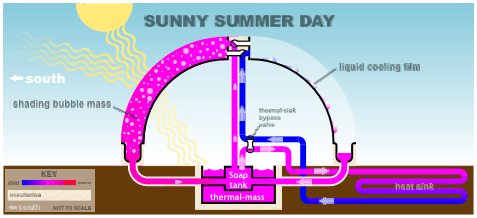Liquid Cooling

click diagram to enlarge
Bubbles used to Shade.
On hot days when the building interior needs to be cooled, bubbles can be maintained in the south cavity to act as shading. When the sun is intense the bubbles will produce an effect like cloud passing over the sun allowing the full spectrum of light useful to plants to penetrate, yet reducing infra-red and heat radiation.
Liquid Cooling Film
To further increase the cooling capacity of the building and perhaps more importantly control humidity, a film of liquid surfactant can be carried in the north cavity. The surfactant properties are not utilised in this process as the liquid is simply the vehicle which transports heat energy from the inner skin to the heat sink. This method of cooling the actual fabric of the building to collect and transfer excess heat actually makes use of the highly efficient biomechanical process called transpiration. This process together with the molecular workings by which transpiration is harnessed within the solarbubblebuild is discussed in the following chapter.
Heat Sink
Before the cooling surfactant solution enters the north cavity it is pumped through coils located within a heat sink. The heat sink shown in the diagram above is simply the ground beneath the build. For a greater cooling capacity coils could be located in a large cool-water thermal mass such as an exterior tank or pond. This in turn can be fed by a stream or pumped ocean water if the location of the building is suitable and the cooling demand is great enough.
|